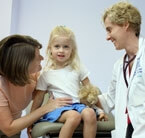
In the aerodigestive clinic, patient Sarah Kilareski with her mom, Carrie, and pediatric gastroenterologist Karla AuYeung.
Sarah was a “blessing from God,” said her mother. “She was full of life and joy, a healthy baby.” But soon after her birth in October 2006, that healthy baby began to choke and spit up a lot. Her pediatrician was not too concerned because Sarah was gaining weight. But at her 12-month well-baby check, she dropped from the 60th percentile on her six-month weight growth chart to 0 percentile and was diagnosed with failure to thrive.
Over the next three months, Sarah underwent a series of tests and procedures, including endoscopy, which was normal, and a barium swallow test that revealed aspiration with thin liquids. Sarah was referred to a pediatric otolaryngologist who concluded that the abnormal findings were due to a developmental delay and recommended anti-reflux medication and adding thickeners to Sarah’s fluids. Despite this therapy, over the next two years she developed chronic lung disease and the abnormal swallowing persisted.
Sarah’s parents sought a second opinion, which took them to the Johns Hopkins Multidisciplinary Pediatric Aerodigestive Clinic (iMPAC), which specializes in the treatment of complex disorders of the airway and upper digestive tract. Instead of individual visits from one specialist to the next, the entire team—pediatric gastroenterologist, otolaryngologist, pulmonologist, and speech-language pathologist—met the patient together in clinic bringing collective insights to bear in the case.
“In the absence of a multidisciplinary clinic, individual specialists order procedures and treat patients in silos, with little coordination and input from one another,” says pediatric gastroenterologist Karla Au Yeung the clinic’s founder and co-director “This piece-meal approach can lead to frustrating—and sometimes critical—delays in diagnosis as patients wait for months to see all doctors and get all tests results.”
To get to the bottom of Sarah’s aspiration reflux problem, Au Yeung used an endoscope to examine her esophagus, and pediatric otolaryngologist Margaret Skinner a bronchoscope to look at her airway around the larynx and voice box. Then they both saw what had been previously missed – a small laryngotracheoesophageal cleft (LTEC), an extremely rare and often easy-to-miss midline opening between the larynx, the trachea and the esophagus. Skinner describes the defect as a notch in the wall between the esophagus and trachea, through which liquids can pass. In severe forms, the notch can extend all the way down to the lungs, making it potentially lethal.
Within two weeks of diagnosis, Sarah underwent cleft repair. Soon after, Sarah’s swallowing normalized. Yet, Skinner cautions that neither the detection nor the optimal treatment would have been possible without a consultative approach where specialists focus on complex conditions in an interdependent manner.
“We are in a circle where none of us individually could manage the condition optimally,” says Skinner. “I need the gastroenterologist’s help before I can fix the cleft, and the pulmonologist needs my help before he can improve airway problems. It really is a collaborative effort.”
The iMPAC team of experts has developed a streamlined strategy to focus on the patients’ evaluation toward an expeditious diagnosis and management plan in clinic and the operating room. Through this team approach, they have diagnosed problems that are only identified with endoscopic procedures under anesthesia, including eosinophilic eosphagitis, laryngeal and tracheal anomalies, and pulmonary infections and aspiration found on bronchial lavage.
With a combined evaluation, the directed treatments may be initiated simultaneously leading to quicker improvement, and even resolution, of symptoms. For example, children whose feeding difficulties, previously thought to be due to gastroesophageal reflux or developmental delay, have resolved with diagnosis and appropriate surgical management of a mild laryngeal cleft.
Swift diagnosis is but one of many benefits of this combined-clinic model. Cost is reduced as a result of fewer clinic visits and fewer missed work days by parents. Other benefits include fewer medications, more enjoyable feeding experience for patients, and even improved exercise tolerance for athletes previously held back by lung disease.
##
